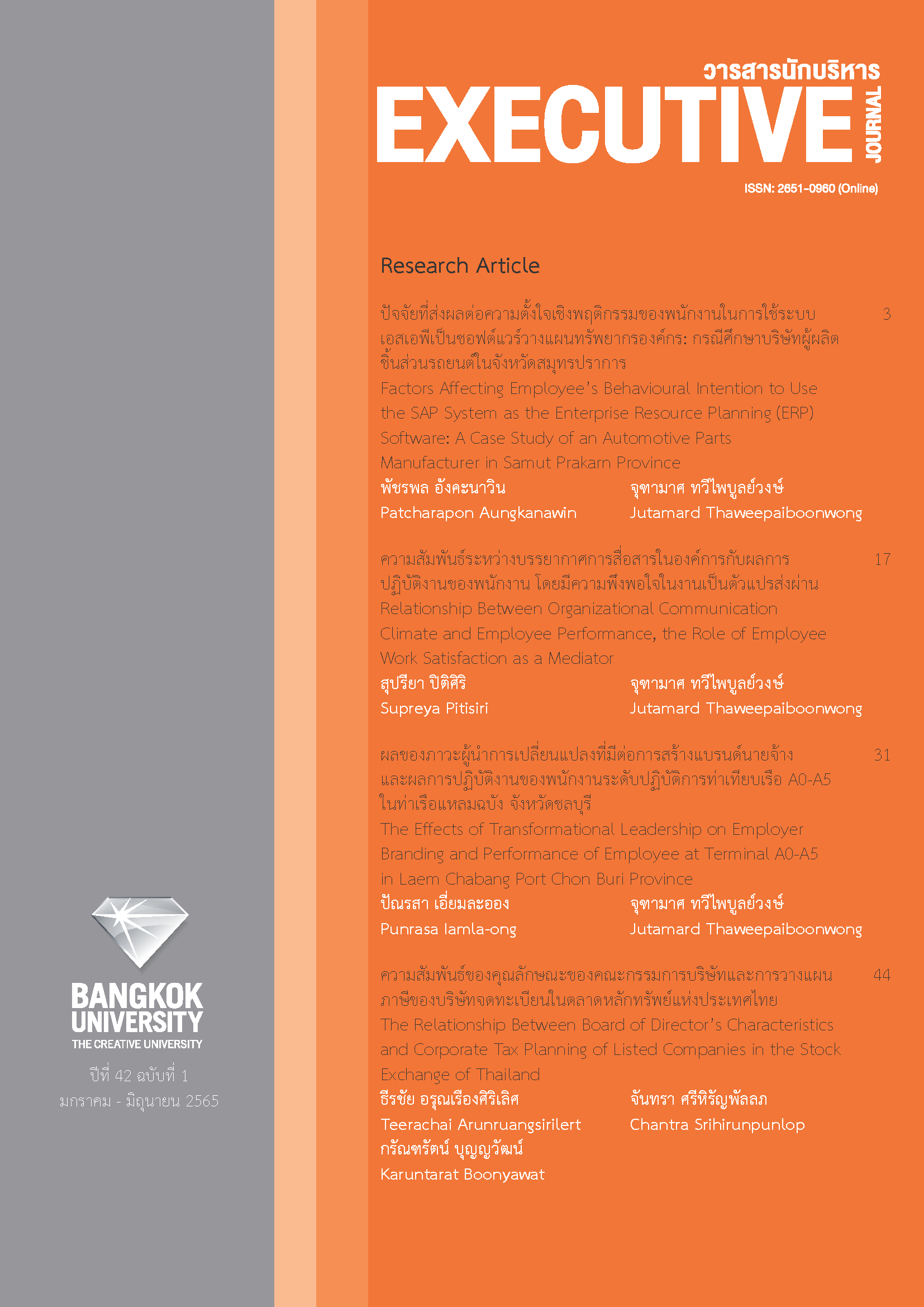Competitiveness of Thai Para Rubber Industry in the People's Republic of China Market
Main Article Content
Abstract
This research aims as following: 1) to analyze the situation of Para Rubber imports in the People's Republic of China Market, and 2) to compare the market structure and competitiveness of Thai rubber with major competitors in the People's Republic of China market. The results found that 1) the value of concentration ratio was greater than 67.00 percent which implies the Chinese rubber import market was a relatively monopolized structure at the top 4 vendors, mainly including Thailand, Malaysia, Indonesia, and Vietnam. 2) The revealed comparative advantage analysis found that Thailand has the comparative advantage in the export to the People's Republic of China market. 3) Thailand Competitiveness Matrix analysis (TCM) found that the competitiveness of Thai Para Rubber in the People's Republic of China market was during a high market demand range, but the competitive capacity is moderate. Therefore, Thai rubber entrepreneurs and related agencies should adjust their strategies by emphasizing on building trade cooperation networks to maintain monopoly power and increase market share.
Article Details

This work is licensed under a Creative Commons Attribution-NonCommercial-NoDerivatives 4.0 International License.
The manuscript submitted for publication must be the original version, submitted only to this particular journal with no prior acceptance for publication elsewhere in other academic journals. The manuscript must also not violate the copyright issue by means of plagiarism.
References
Balassa, B. (1965). Trade liberalization and revealed comparative advantage. Manchester School
of Economic and Social Studies, 33(2), 99-123.
Bowornkulwat, W. (2011). Kānsưksā khwāmsāmāt nai kān khǣngkhan læ sakkayaphāp chœ̄ng lưk
khō̜ng ʻutsāhakam yāng thammachāt nai prathēt [An in-depth study of the
competitiveness and potential of the natural rubber industry in Thailand] (Master’s thesis,
Thammasat University).
Bureau of Agricultural Commodities Promotion and Management. (2012). Sarup phonlakā rasam manā kānčhatkān khwāmrū samnak songsœ̄m læ čhatkān sinkhā kasēt rư̄ang kān wikhro̜
sakkayaphāp kān khǣngkhan phư̄t sētthakit phư̄a rō̜ng rap AEC [Summary of the nowledge management seminar Bureau of Agricultural Product Promotion and Management subject: Competitive potential analysis of economic crops to support AEC]. Retrieved December 20, 2017, from http://www.agriman.doae.go.th/home/02km%20wg/km55/02_%2025%2009%2055.pdf
Chuasuwan, C. (2018). Nǣonōm thurakit/ʻutsāhakam pī Phō̜.Sō̜. sō̜ngphanhārō̜ihoksipʻet –
sō̜ngphanhārō̜ihoksipsām: ʻutsāhakam yāngphārā prǣrūp [Industrial business trends 2018-
: Processed rubber industry]. Retrieved October 30, 2018, from https://www.krungsri.com/ bank/getmedia/59178975-3492-43d7-901c-8f7fc119b729/IO_Rubber_2018_TH.aspx
Kaosa-Ard, M. et al. (2015). Phǣnngān khrōngkān kān songsœ̄m sakkayaphāp ʻutsāhakam
thō̜ngthīeo læ lǣng thō̜ngthīeo khunnaphāp sūng (rāingān kānwičhai) [Promoting the
potential of hi-value tourism industry and hi-value destination (Research report)]. Chiang Mai: Public Policy Studies Institute.
Manusook, A. (1998). Sētthasāt khrōngsāng læ phrưttikam khō̜ng ʻutsāhakam [Economics of
industrial structure and performance]. Bangkok: Ramkhamhaeng University Press.
Office of Agricultural Economics. (2019, December). Sathānakān sinkhā kasēt thī samkhan læ
nǣonōm pī sō̜ngphanhārō̜ihoksipsām [Situation of important agricultural products and trends in 2020]. Retrieved June 16, 2021, from https://www.oae.go.th/assets/portals/1/files/trend2563-Final-Download.pdf
Poramacom, N. (2002). Revealed comparative advantage (RCA) and constant market share model
(CMS) on Thai natural rubber. Kasetsart Journal (Social Sciences), 23(1), 54-60.
Sowcharoensuk, C. (2019, June 17). Nǣonōm thurakit / ʻutsāhakam pī -: ʻUtsāhakam yāngphārā
[Industrial/business trend 2019-2021: Rubber industry]. Retrieved August 30, 2019, from https://www.krungsri.com/th/research/industry/industry-outlook/agriculture/rubber/IO/io-rubber-20
Suriya, P. (2013). Sakkayaphāp kān khǣngkhan khō̜ng phāk kān kasēt Thai lang pœ̄t prachākhom
sētthakit ʻĀsīan (ASEAN Economic Community: AEC) [The competitive potential of the Thai
agricultural sector after the opening of the ASEAN Economic Community]. Khon Kaen
Agriculture Journal, 41(2), 101-106.
Thai Chamber of Commerce in China. (2018). Rāingān khrōngkān sakkayaphāp sinkhā yāngphārā
Thai nai talāt Čhīn (Rāingān kānwičhai) [Report of the project on the potential of Thai rubber products in the Chinese market (Research report)]. Beijing: Author.
Tsikata, Y. (1999). Liberalization and trade performance in South Africa. Washington, DC:
World Bank.
UN Comtrade. (2018). UN Comtrade database. Retrieved October 16, 2018, from https://comtrade.un.org/data/
Untong, A., & Phaokrueng, A. (2010). Khwāmsāmāt nai kān khǣngkhan khō̜ng sinkhā kasēt thī samkhan
khō̜ng Thai nai talāt Čhīn [The competitiveness of Thai agricultural commodities in the
Chinese market]. CMU Journal of Economics, 14(1), 22-47.
Yu, R., Cai, J., & Leung, P. (2009). The normalized revealed comparative advantage index. The
Annals of Regional Science, 43, 267–282.


